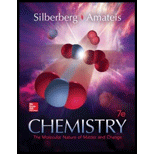
Concept explainers
(a)
Interpretation:
Moles of ion released when
Concept introduction:
A solution is a combination of two parts: solute and solvent. A solute is the substance that is present in small quantity and solvent is the substance in which solute is dissolved. When water acts as a solvent then it is known as an aqueous solution.
Ionic compounds are the compounds that are composed of charged ions. They are held together by electrostatic forces. These compounds dissociate into ions when dissolved in water.
The expression to calculate the moles of ions is as follows:
(a)
Answer to Problem 4.19P
Explanation of Solution
One mole of
The expression to calculate the moles of ions of
Substitute
One mole of
(b)
Interpretation:
Moles of ion released when
Concept introduction:
A solution is a combination of two parts: solute and solvent. A solute is the substance that is present in small quantity and solvent is the substance in which solute is dissolved. When water acts as a solvent then it is known as an aqueous solution.
Ionic compounds are the compounds that are composed of charged ions. They are held together by electrostatic forces. These compounds dissociate into ions when dissolved in water.
The expression to calculate the moles of ions in a compound is as follows:
(b)
Answer to Problem 4.19P
Explanation of Solution
One mole of
The molecular mass of
The expression to calculate the moles of ions in
Substitute
One mole of
(c)
Interpretation:
Moles of ion released when
Concept introduction:
A solution is a combination of two parts: solute and solvent. A solute is the substance that is present in small quantity and solvent is the substance in which solute is dissolved. When water acts as a solvent then it is known as an aqueous solution.
Ionic compounds are the compounds that are composed of charged ions. They are held together by electrostatic forces. These compounds dissociate into ions when dissolved in water.
A formula unit is used for the ionic compound to represent their empirical formula. The expression to calculate the moles of ions in a compound is as follows:
(c)
Answer to Problem 4.19P
Explanation of Solution
One mole of
The expression to calculate the moles of ions in
Substitute
One mole of
Want to see more full solutions like this?
 ChemistryChemistryISBN:9781305957404Author:Steven S. Zumdahl, Susan A. Zumdahl, Donald J. DeCostePublisher:Cengage Learning
ChemistryChemistryISBN:9781305957404Author:Steven S. Zumdahl, Susan A. Zumdahl, Donald J. DeCostePublisher:Cengage Learning ChemistryChemistryISBN:9781259911156Author:Raymond Chang Dr., Jason Overby ProfessorPublisher:McGraw-Hill Education
ChemistryChemistryISBN:9781259911156Author:Raymond Chang Dr., Jason Overby ProfessorPublisher:McGraw-Hill Education Principles of Instrumental AnalysisChemistryISBN:9781305577213Author:Douglas A. Skoog, F. James Holler, Stanley R. CrouchPublisher:Cengage Learning
Principles of Instrumental AnalysisChemistryISBN:9781305577213Author:Douglas A. Skoog, F. James Holler, Stanley R. CrouchPublisher:Cengage Learning Organic ChemistryChemistryISBN:9780078021558Author:Janice Gorzynski Smith Dr.Publisher:McGraw-Hill Education
Organic ChemistryChemistryISBN:9780078021558Author:Janice Gorzynski Smith Dr.Publisher:McGraw-Hill Education Chemistry: Principles and ReactionsChemistryISBN:9781305079373Author:William L. Masterton, Cecile N. HurleyPublisher:Cengage Learning
Chemistry: Principles and ReactionsChemistryISBN:9781305079373Author:William L. Masterton, Cecile N. HurleyPublisher:Cengage Learning Elementary Principles of Chemical Processes, Bind...ChemistryISBN:9781118431221Author:Richard M. Felder, Ronald W. Rousseau, Lisa G. BullardPublisher:WILEY
Elementary Principles of Chemical Processes, Bind...ChemistryISBN:9781118431221Author:Richard M. Felder, Ronald W. Rousseau, Lisa G. BullardPublisher:WILEY





